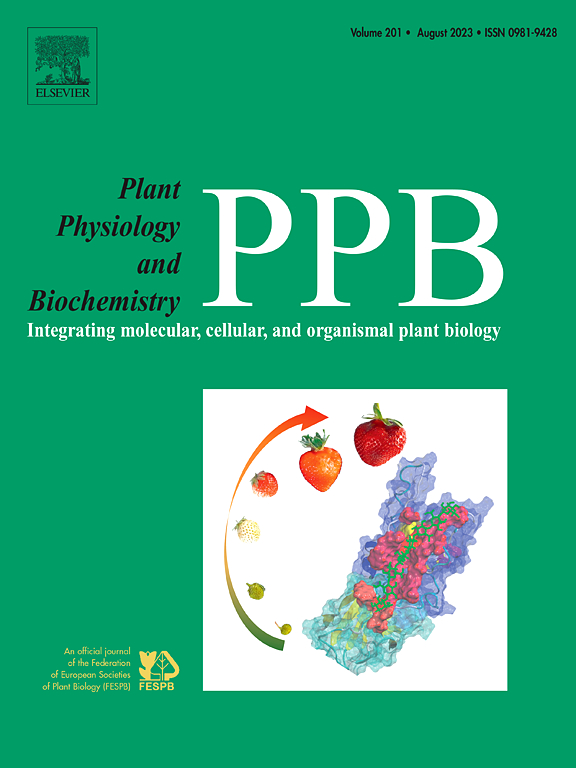巴西棘球藻抗als抑制剂机制的变异和空间分布
IF 5.7
2区 生物学
Q1 PLANT SCIENCES
引用次数: 0
摘要
稗子草(Echinochloa cross -galli, L.)(P. Beauv.)是一种六倍体杂草,常见于稻田。稗草抗除草剂机制的田间频率仍然未知。本研究开发并比较了用于检测ALS基因突变的分子标记方法,分析了其在巴西南部稻田中的频率和空间分布。对52份材料的ALS基因进行测序,以确定与抗性相关的突变。建立了单核苷酸扩增多态性(SNAP)和PCR等位基因竞争扩展(PACE®)标记,用于检测ALS突变:A122T、A205N、W574L和S653N。共收集到经咪唑啉酮处理后存活的植物233株。温室试验分别鉴定出195个和84个品种对伊马扎吡+伊马扎吡和培诺舒兰具有抗性。分子分析检测到188份耐药菌株,其中W574L、S653N、A122T和A205N突变分别出现在43%、29%、17%和5%的耐药样本中。6%的材料在两个位置携带突变,而6个抗性材料没有任何突变。SNAP法和PACE法的有效率分别为90%和82%。使用纳米孔测序解决了方法之间的差异。检测阈值为每25个敏感DNA样本中有1个耐药样本,在SNAP中每10个叶片样本中有1个耐药样本。所有突变均有地理分布,W574L的频率从2017/2018年的40%增加到2022/2023年的47%。在80%的材料中检测到ALS抗性。像这样追踪抗性机制的流行病学研究,包括突变的发生、分布和变异性,对于改进杂草控制建议至关重要。本文章由计算机程序翻译,如有差异,请以英文原文为准。
Variability and spatial distribution of ALS-inhibitor resistance mechanisms in Brazilian Echinochloa crus-galli
Barnyardgrass (Echinochloa crus-galli (L.) P. Beauv.) is a hexaploid weed, commonly found in rice fields. The field-level frequencies of the herbicide resistance mechanisms present in barnyardgrass remain unknown. This study developed and compared molecular marker assays for detecting mutations in the ALS genes, analyzing their frequency and spatial distribution in Southern Brazil rice fields. The ALS gene of 52 accessions was sequenced to identify mutations associated with resistance. Single Nucleotide-Amplified Polymorphism (SNAP) and PCR Allele Competitive Extension (PACE®) markers were developed for detecting ALS mutations: A122T, A205N, W574L, and S653N. A total of 233 accessions that survived imidazolinone application were collected. A greenhouse assay identified 195 and 84 accessions resistant to imazapyr + imazapic and penoxsulam, respectively. Molecular assays detected 188 resistant accessions, with W574L, S653N, A122T, and A205N mutations present in 43 %, 29 %, 17 %, and 5 % of resistant samples, respectively. 6 % of accessions carried mutations in two positions, while six resistant accessions lacked any mutation. Efficiency of SNAP and PACE methods was 90 % and 82 %, respectively. Discrepancies between methods were resolved using Nanopore sequencing. The detection threshold was one resistant per 25 susceptible DNA samples and one per 10 using leaf discs in SNAP. All mutations were distributed geographically, with the frequency of W574L increasing from 40 % in 2017/2018 to 47 % in the 2022/2023 season. ALS resistance was detected in 80 % of the accessions. Epidemiological studies, like this, that track resistance mechanisms, including the occurrence, distribution, and variability of mutations, are crucial for improving weed control recommendations.
求助全文
通过发布文献求助,成功后即可免费获取论文全文。
去求助
来源期刊
CiteScore
11.10
自引率
3.10%
发文量
410
审稿时长
33 days
期刊介绍:
Plant Physiology and Biochemistry publishes original theoretical, experimental and technical contributions in the various fields of plant physiology (biochemistry, physiology, structure, genetics, plant-microbe interactions, etc.) at diverse levels of integration (molecular, subcellular, cellular, organ, whole plant, environmental). Opinions expressed in the journal are the sole responsibility of the authors and publication does not imply the editors'' agreement.
Manuscripts describing molecular-genetic and/or gene expression data that are not integrated with biochemical analysis and/or actual measurements of plant physiological processes are not suitable for PPB. Also "Omics" studies (transcriptomics, proteomics, metabolomics, etc.) reporting descriptive analysis without an element of functional validation assays, will not be considered. Similarly, applied agronomic or phytochemical studies that generate no new, fundamental insights in plant physiological and/or biochemical processes are not suitable for publication in PPB.
Plant Physiology and Biochemistry publishes several types of articles: Reviews, Papers and Short Papers. Articles for Reviews are either invited by the editor or proposed by the authors for the editor''s prior agreement. Reviews should not exceed 40 typewritten pages and Short Papers no more than approximately 8 typewritten pages. The fundamental character of Plant Physiology and Biochemistry remains that of a journal for original results.

 求助内容:
求助内容: 应助结果提醒方式:
应助结果提醒方式:


